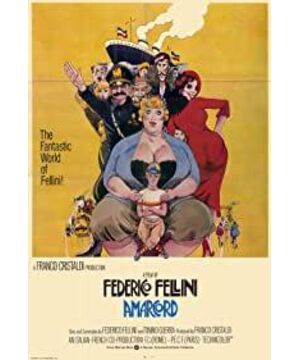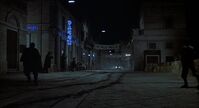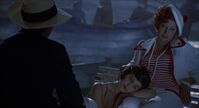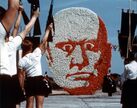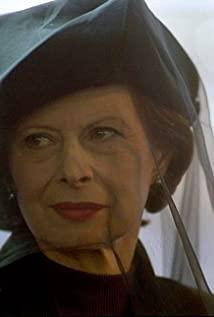"Amacorde" is one of the most prestigious works of Italian director Federico Fellini, and has won many awards including Oscar for Best Foreign Language Film. This article intends to analyze the image style and core image of Fellini's work sequence, and try to make a targeted comment on "Amacorde". 1. Fellini's world picture Fellini once said in an interview that he has always only made the same movies, and he can't distinguish the movies he has made. In fact, all Fellini's films are semi-autobiographical, rooted in his own life experience, personal fantasy and early imaging practices. As Peter Warren said, a director only shoots "one movie" in his life, which means that in their sequence of works, there is a deep structure that is almost stable, and the role of film critics is to try to It's revealed. We can see this structure in the five pairs of core contradictions that run through Fellini's world picture.
The first is the contradiction between vulgarity and poetry. This is most evident in "Amakode" (1973), which will be discussed later. In Fellini's films, down-to-earth dialects and vulgar jokes are often seen, and the depiction of brothels is all over the film. Erotic fantasy sometimes interrupts the normal narrative time and space. However, while not concealing sex, desires, and sexual fantasies, the director also puts in many romantic and poetic scenes, which neutralizes the lippa-like plots to a certain extent. This poetry flashes in the gorgeous setting in "Juliet and the Devil" (1965), is presented in the silver mechanical bird dancing in the rapport scene of "Casanova" (1976), and rises in "The Waver" (1953) ) At the end, the train bid farewell and cut into the moving shots of pulling away from the four-person bedroom, blended in the beautiful verses of "Women City" (1980) ("The vagina is like a clam, it is the sound from the ocean, singing the most beautiful mermaid Ballad"). The unity of opposites between noisy carnival and loneliness and sadness is also the eternal motif of Fellini. Almost every film of Fellini cannot be separated from the participation of parades/group ceremonies, circuses and clowns. This is closely related to the shocking experience of the director sneaking out to watch the small town circus performance in his childhood. Since then, jugglers and clowns have been stationed in his heart, and they continue to reproduce in the images, even becoming "The Clown" (1970) The absolute hero of a piece.
However, in the background of the lively carnival, there are cold and deep thoughts, and under the colorful masks in front of the curtain, the eyes that understand the cold and warm world of the world are shaded. As Chaplin said: "The world is like a huge circus. It excites you, but it makes me panic, because I know it will always be-limited tenderness and infinite sadness." (1) " "Sweet Life" (1960) reveals the rootless state of spiritual loneliness and emptiness behind the life of drunken gold fans in Rome’s upper class; the end of love between the rugged wandering entertainer Zambano and the foolish clown Jesomina in "The Road" (1954) Disillusioned by Zambano’s stupidity, the awake prodigal had to endure the erosion of endless loneliness alone; Casanova, who had tasted the taste of love, chose a machine that would never change his heart when he was old. Women hug and dance; at the end of "Joker", the clown blows an infinitely sad trumpet, but it is never possible to recall the dead partner. The sadness after the end of the song is more than this. The carnival will eventually come to an end, and the sense of emptiness will suddenly come to mind. After the uproar, there is nowhere to hide the sadness.
The images that signify the carnival are the circus, the wandering entertainers, and the clowns, and the image of loneliness is the "solitary clearing at dawn", which appears frequently in Fellini's films: A Romance Painting (1972) The shot shows the empty streets in the early morning, the banquets are scattered, leaving only confetti flying, only the welding blue light in the slow pan reminds us that we are still in the world; the ending of "Casanova" focuses on the empty square of Venice in the middle of the night , The old love is dancing with the dolls; in "Lang Dang Er", the camera repeatedly patrols the lonely square in the small town in the early morning. Fellini is also in love with the sea, and "The Road" shows his loneliness and regret with Zambano's tearing tears of loneliness on the beach at night. The ending of "Sweet Life" still tends to the sea, and uses the strange whale stranded to refer to the middle class's inner alienation, like a living state like a walking dead. The third set of binomial opposites in Fellini's works are loyalty and debauchery. Although it is a common attribute between the two sexes, we can only see three typical characters: a flower-hearted man, an infatuated woman and a prostitute, while most loyal men are absent and are not in the director's world. It is also based on this that many viewers regard Fellini as a practitioner of male chauvinism. I think that Fellini can't completely escape the patriarchal vision, but he has awe and love for women. The inability to break away from the patriarchal perspective is mainly reflected in the close-up shots of women in the status of being viewed in their images. It is a patriarchal mode of operation), which is most obvious in "Women City", which is suspected of demonizing feminism. In other works, there is no shortage of male subjective lens shots that regard women as objects of desire.
However, in Fellini's human juggling arena, the male protagonist always seems to be in a state of experiencing scarcity and pain, sinking into inner conflict (except for the so-called "Juliet and the Devil", which is famous for its feminine perspective). In classic movie narratives, the male protagonist who has always occupied the position of female savior often no longer exists, and is replaced by the woman responsible for saving the male. However, due to the lack of male power and moral entanglements, as well as the decline of Christian authority (or subtle or explicit religious ridicule is everywhere, especially in "Sweet Life" and "Roman Style Painting"), Fellini’s films are directed towards men. The power of redemption will not come from religion. It is Fellini's expression from beginning to end that the slutty woman saves the fallen body of the man, and the holy woman saves the fragile soul of the man. In "The Great Road", Jessomena's death finally awakens Zambano, making her heartless heart feel the beauty of love and the loneliness of a lost partner. In "The Drifter", Sandra's action of leaving with anger made Faust realize the preciousness of the family, and finally reformed. In addition, the female image close to the incarnation of the Virgin also has a place in Fellini’s world, such as the prostitute card who is innocent and kind in "Night of Kabylia", who is tough and optimistic even after repeated tricks, and is willing to give everything for true love. Villa, and the woman who helped Serbian refugees in "The Ship Continues" (1983). On the whole, in Fellini’s world, slutty women (especially prostitutes) are not uniformly labeled as morally corrupt, and the slutty male protagonist is not only in a situation that is difficult for the audience to fully agree with. In terms of morality, the film also encounters a mental crisis that is difficult to get rid of. In the middle and late works, the possibility of salvation for men tends to be empty, and the opening and closing situations remain unchanged. Here, for men, women are not merely objects of desire to be rescued or abandoned. They are also teachers of sexual enlightenment, mothers who are all-inclusive, and the only subject that can save men.
The fourth pair of core contradictions is reality and fantasy. Just like Fellini’s most famous confession: Dream is the only reality. The director who followed the leader of Italian new realism Rossellini gradually derailed from the new realism in the 1950s, and in 1960 " "Sweet Life" completely parted ways with it. Since then, his works have always included passages that directly present imagination, memory, dreams or hallucinations. This trend has gradually intensified. In "Eight and a half" (1963), the proportion of inner images is low, and there is still a distinguishable boundary between illusion and reality. However, in "Juliet and the Devil", fantasy and reality are equally divided. It is difficult to distinguish, as far as "Women City", only the beginning and the end of the whole film occur in reality, and the rest are illusory. In the posthumous work "Moon Yin" (1990), the world view from the eyes of schizophrenic patients constitutes the whole film. , The virtual and the real are completely united. This "Fellini-style" style is also called "psychological realism". It is precisely in this definition that the contradictions between fantasy/inner mind and reality/external objects are juxtaposed.
In terms of film performance, this contradiction can also be equivalent to the unity of opposites between record and performance. In "The Clown", Fellini first reproduced the passage of sneaking into the circus to watch the performance when he was a child, and then inserted some interviews with clowns who used to make a living in the circus. In this way, the director was not only able to combine the truth and fiction in a film, but also occasionally aroused the audience's doubts about the truthfulness of the recorded part. Two years later, "Roman Style Painting" further eliminated the boundary between record and fiction. Rome as a city replaced the characters in traditional dramas as the protagonists, but in the shooting of the customs of the Eternal City, some surreal elements gradually emerged in the picture. For example, the flatbed carts, horses and tanks in the road traffic, and soldiers in different costumes in the railway station belong to different eras, and even include incredible, flashy and extravagant church fashion shows. In addition, Fellini set up a variety of scenes with great performance in the film (cinema, theater, parade, sightseeing, open-air dinner, brothel soliciting performance), and also made the audience doubt: those in the film that seem to be documentary Are all the paragraphs performed manually?
Another visual image that covers almost all of Fellini's works is: a person (or creature) hanging between the sky and the earth. In my opinion, the contradiction between reality and illusion is faintly revealed in this image. This image implies that people are stuck in heaven (ideal/dream) and earth (reality), but in the end they still have to return to reality (falling or landing) and face the unsatisfactory life. As shown in the opening dream of "Eight and a Half", Guido climbed out of the window in the crowded traffic and flew to the sky, but was immediately pulled down by a rope tied to his feet and fell into reality. Variations of this imagery include: a tightrope walker-"Big Road", a man who was frustrated by an earthquake with an attempt to hang himself-"Myth of Love" (1969), floating flowers and a wicker basket leading to a tree house "elevator" "-"Juliet and the Devil", climbing ladders, rope nets and beautiful hot air balloons but finally shot down by a submachine gun (foreshadowing the big dream will wake up)-"Women City", a rhino hanging in mid-air -"The Ship Continues Forward", etc.
Tradition and rebellion are another unity of opposites. It is contained in the spirit and audio-visual language of Fellini's works. In Fellini's works, there is often an unruly bloodline: children are always rebellious and surly, and fantasies are always unscrupulous. At the same time, Fellini's affection for clowns and circuses is rooted in traditional Italian culture. Fellini holds a negative and mocking attitude towards television, a new medium that gradually dominates the entertainment life of mankind, just like the confusion of truth and falsehood, the ubiquitous live television broadcast and the densely dense "antenna forest" in "Moon Yin".
Fellini's "Eight and a half" and subsequent works are recognized as "modernist" films by film critics. The commonly used audio-visual language that is different from classicism, in addition to the seamless connection of reality and reality or stream of consciousness as mentioned above, also includes self-reference to the film medium: in the road traffic jam passage of "Roman Style Painting", The camera’s rocker enters the lens, exposing itself to the filming mechanism; in films such as “Casanova” and “The Ship Continues Forward”, the sea surface is made of plastic cloth blown by a blower and is clearly and intuitively displayed to the audience. Deliberately revealing the falseness and exaggeration of the setting, making it difficult for viewers to fully participate in the movie; in "The Ship Continues Forward", the black and white silent film begins, gradually turning into sound, until the color image, which reproduces the history of film to a certain extent. Technological evolution, the end of the film ended with a picture showing the studio, and even a camera slowly pushed forward until it was completely docked with the screen (another camera)—the opening shot of Godard's "Contempt" (1963) Same result with the same result. In addition, during the filming process, Fellini is always used to playing music on set, and sometimes he asks the symphony orchestra to accompany him live. Because the tradition of Italian films at the time was to add all the dialogue and sound effects later, this method not only does not interfere with the filming, but also allows the actors to move and act according to the beat of the music. This is how the characters in Fellini's films move like dancing. s reason. Regarding the specific presentation of traditional film language conventions in Fellini's films, the following will take "Amacorde" as an example for analysis. I just want to point out that in the category of so-called art films or author films, most of Fellini’s works are not characterized by subverting or deconstructing traditional film language (for example, "Amakod" compared with Tarkovsky's "Mirror" (1975), you can also compare the works of Fellini and Alan Renai, Godard, etc.), but is more inclined to borrow traditional film conventions to write his own world view. 2. Fellini's world hometown film "Amacorde" presents the daily picture of Fellini's hometown of Rimini and his childhood life. Unlike traditional autobiographical themes, this film is not a purely objective autobiographical film based on the reproduction of history and reality. Rather, Fellini combines his (memory-distorted) personal experience with the ideal appearance of the small town in his mind. In this way, he created a picture scroll of "Hometown of the World" that is higher than reality and can arouse the audience's true feelings. For a film like "Amacord" with many characters and complicated content, a fairly effective method of analysis is to list the segmentation table. The film can be divided into 43 paragraphs or scenes. For the convenience of readers' understanding and self-reference analysis, the following are listed below: Opening 1.
Compared with traditional narrative movies, the narrative of "Amacord" is scattered and trivial, and the film lacks a conflict that can closely link all the plots together. But the most subversive film language is undoubtedly the setting of the role of storyteller. A similar setting can be traced back to "Round Dance" (1950) directed by Max Opheles. As an omniscient narrator, a "game controller", like a god, can enter the story at any time and even change the trajectory of the plot development. . In the sequence of Fellini's works, this character does not show the ability to manipulate the story at will, and is more like a narrator. You can see everything from "Joker", "Amacord" to "The Ship Continues Forward". His figure. In this film, the storyteller, the lawyer, interrupted the conventional narrative six times, stared at the camera to explain, and broke the self-sufficiency and closure of the illusion world of the screen, thus deconstructing the film's dream-making mechanism to a certain extent. However, the storyteller’s own commentary has also been interrupted many times by the behavior of the characters from outside the screen, such as the "fat" sound from outside the picture, the snowball hitting the storyteller, etc. (It is easy to think of the scene of "Joker" : A trash can flies out of the cover on Fellini, who is answering the question). The film uses this double interruption to break the coherent narrative of traditional movies, and at the same time produce irony and humorous effects.
Paragraph 21 introduced by the storyteller-the hotel recalls the scene. The story is divided into two parts in the screening time (just at the midpoint) and plot structure (a plot independent of the main line). The scene and plot of the first part are basic All are in line with history or real life, and the possibility of actual occurrence is greater. In this part, scenes imagined or recalled by the protagonist are clearly marked and follow the conventions of the movie. For example, the flashbacks in the church confession run through Tita's inner monologue, and use a fast zoom to show the children's gaze on women. In the military parade scene, the camera gradually moved forward, Cicio closed his eyes, smiled, showing a look of intoxication, and then opened his eyes again, and then turned back to his imagination-the big head of Mussolini spoke. Presided over the wedding of Cicio and his favorite person. Most of the scenes in the film that are full of poetry, true and illusion, appear in the second part. Scenes such as the white cow in the fog, the a cappella group dance, and the peacock in the snow are almost impossible to occur in reality, but in the language of the film, there is no clear sign that reveals it as a fantasy or a dream.
It was when recalling the scene in the big hotel that the illusion and reality began to gradually overlap, and it was difficult to clearly distinguish the true from the false in the second part of the film. This scene's expression of illusion and reality is also a classic example of Fellini's combination of traditional film language conventions and anti-traditional methods. Insert paragraph 1 focuses on Gladska’s night adventures. The camera slowly shakes through the empty dark lobby. Gladska starts to climb the stairs. The camera switches to a bright interior, Gladska. Seeing the prince, my heart was rippling. She began to take off her clothes, showing her grace, and finally lying on the bed, confessing to the prince "Gradiska (whatever you want)". Here, Fellini used the technique of lens separation in traditional audio-visual language, implying that this passage is purely a fantasy of Gradiska. From beginning to end, neither Gradiska and "His Royal Highness" appeared in the same shot at the same time. Instead, there were shots that cut across each other. This refers to a state of opposition between the two that is completely incommunicable. Diska's subjective perspective is consistent, and it also faintly reveals a conjecture. In contrast, inserting the last few shots in paragraph 2 (Bixin narrated that he entered the harem of the Muslim nobleman and his desires were fully satisfied), allowing Bixing to appear in the same scene with his Muslim wives and concubines, subverting the previous paragraph. The audio-visual conventions have blurred the boundary between reality and illusion, and it is impossible to confirm. ""Amacord" adopts some classic methods that have existed in ancient times, such as seasonal rotation, alternate forms of expression to achieve the best results, and the transition from comedy to melancholy." (2) The film begins in spring, It ended again with the arrival of spring in the new year. In the last 20 minutes of the film, illness, hospital, death, and funeral appear one after another, changing the tone of the film from joy and joy to melancholy and sadness. The wedding at the end turned the low mood up, but the scene is still mixed: Let’s leave aside the gloomy future faintly foreshadowed by the identity of Gradiska’s new husband (fascist cavalry), bid farewell to the town’s " "Goddess", for the protagonist, is nothing more than a farewell ceremony to say goodbye to childhood, and it will become a memory that is engraved in the heart but not without sourness. The rotation of the four seasons, funeral marriages, and leaving the country are the motifs with a long history, but they still bear the personal brand of Fellini here.
Fellini's use of traditional film rhetoric strategies is also reflected in the film editing. Except for some hard-cut transitions, the transitions of many paragraphs have used the method of fade-in and fade-out. In the conventional grammar of movies, fade in and out is an ellipsis of time. When we think about it carefully, this technique also secretly fits the emotions of nostalgia and homesickness-the pictures of the hometown flow along with the memory, and gradually become clear in our minds. When we have to stop the memories and return to the trivial things of reality, the scenes of the past slowly Fading away, the remaining sound is curled, and the lasting charm is long. In terms of sceneries, Fellini mostly chooses mid-range or long-range scenes in this film. This appropriate sense of distance is also compatible with the characteristics of memories. Just like when we look back on the past, the twilight that penetrates the years, everything is covered. A layer of light gauze makes it difficult to completely eliminate the sense of isolation. The close-ups in the film are mostly used to emphasize and highlight the protagonist’s desire objects of sexual enlightenment, such as the flashbacks of children’s masturbation in paragraph 14 and the close-up of the butt of the Victory Monument statue-this statue is used in paragraphs 12 and 34. Presented as the objects of children's desire, the sacred and erotic tastes complement each other. After the close-up of the butt in paragraph 12, the cut is a distant shot of the child staring at the statue making a thrusting motion.
The theme song composed by Fellini's queen music scorer Nino Rota for the film is melodious and tactful, soaked in the lingering nostalgia, which adds a lot to the film. Among the many small town characters portrayed by Fellini, Tita's father is one of the most vivid and vivid images. In paragraph 9, the father was furious with Tita’s mischief and his arms trembled. Then he heard his mother threaten to "put arsenic in the soup before committing suicide" because of his anger and boredom. The father immediately put his hands in his mouth. In the middle of the game, he stretched his mouth to its maximum, as if he was about to split the upper and lower jaws; after Uncle Theo wet his pants and returned to the car, he yelled at his running brother: "Come here, otherwise I will throw myself under the wheel Seeing that the uncle on the tree refused to come down, he threw his hat on the ground and jumped again: "I am a bastard, a stupid bastard!" It is also the uncle who refuses to go down the tree like a child. A character worthy of sympathy, he took out the stones in his pocket, and his mother was puzzled: "Aren't they heavy?" "These stones are beautiful," the uncle replied. And Uncle Theo sitting on a dense tree branch has since become another "person hanging between the sky and the earth" in Fellini's image sequence. In addition, Fellini enhanced the visual impression of the dress colors of the two female characters. In addition to wearing a pure white wedding dress at the end, Gratiska always wore a red coat, and the prostitute Verbina was dressed in green every time she appeared. Does this imply the color of value judgment?
The irony of the film against the fascist regime is not only reflected in paragraphs 15 to 20. In paragraphs 24 to 26, the whole town flocked to take off in small boats just to get a glimpse of the true face of the giant ship. The name of the ship "Rex" (Rex) means "king" in Latin, and with the cheers of the masses, "This is the greatest thing the regime has made", the reference to Mussolini's regime has become clear. Ruohui. The journey to find the Rex spans day and night, and its true body slowly emerges in the vast night fog, and is presented in an upward-looking lens that makes people unconsciously awe-inspiring. The panoramic view of the giant ship never appeared clearly in the audience's field of vision. Instead, it was replaced by a close-up shot of the middle and upper part of the hull that occupies most of the screen, with an exciting and ups and downs themed soundtrack. The use of various techniques has made the night view of the big ship a pilgrimage ritual with implicit fascist references. After the great ship faded out, a shot was suddenly cut into, showing a turbulent and undulating seascape. At this point, the audience can recognize the texture of the plastic set set at a glance (the same quality as "Casanova" and "The Ship Continues Forward" ). Fellini might be suggesting that the so-called fabulous national image of Italy in people's minds is just a false illusion built in a studio, like a bubble that cannot withstand touch. It is worth mentioning that a similar giant ship appeared again in "The Ship Continued", but at the end it sank like the Titanic.
The fog in paragraph 27 is the most poetic part of the film, dreamlike. Fellini externalized the subconscious fears and desires of people of different ages. Faced with the night fog, the old man secretly prayed: "If death is like this...I will not think about it too much", and at the same time exposed the deepest fear: "I even Can't find my house, where am I?" The attachment to the homeland (resisting the gnawing of loneliness) and the ambiguous psychology of death are destined to be an unresolvable frustration in the hearts of many older people. The little boy saw the white cow looming in the dense fog, just like the monster in the dark night we feared deeply in our childhood. When the theme soundtrack from outside of the narrative (there is no sound source in the picture or in the story environment) sounded, the young people in the square began to dance gradually, although they were empty in their hands, they still held the violin, guitar or flute posture, and played on their own With the imaginary instrument. This piece of virtual dance out of thin air not only demonstrates the carefree, romantic and casual mentality of young people, but also complements Fellini’s usual studio shots. As mentioned earlier, Fellini’s music played on set makes The movements of many actors are as graceful as dancing to the beat, as if they have heard dance music that does not exist in the play.
Some scenes of "Amacord" always evoke memories of other films. Paragraph 32 often reminds me of the snow watching scene in Angelopoulos' "Landscape in the Mist" (1988)-Ula and Alexander heard of snow and rushed out of the room. The outside world was white and quiet, everyone Putting down the affairs in hand, stopped and looked up at the snowflakes falling from the sky, like a group of sculptures standing in the snow. The recurring Motorcycle Speeding Party has previously been previewed in Fellini's "Roman Style Painting". In the last two shots of paragraph 28, on the streets in the early morning, Lalo picked up an ear in the dust raised by the speeding car, just like the echo of David Lynch’s "Blue Velvet" (1986) traveling through time and space. .
The sudden heavy rain at the end of the wedding made me relive the similar scenes in "The Traveler in Time and Space" (2013) that I had seen before. I have always thought that an unforgettable wedding does not necessarily have to be complete, everything goes well, and the sudden wind, frost, snow and rain can better reflect the beauty of love than Jin Jian.
The movie theater scene in this film can also recall Tonadore’s "Paradise Cinema" (1988). Perhaps Tonadore was more or less influenced by Fellini, otherwise, why is Renardo’s love for Malena in "The Beautiful Legend of Sicily" (2000) so close to Tita’s What do you think of the goddess of the town? The collective banquet at the end of "Amacord" can also be regarded as a variation of the ending of the circus performance of "Eight and a half". This kind of rally/carnival ending is likely to affect Kusturica The ending of "Underground"—the inevitable place of surreal reunion is stained with sadness, but it also has a touch of acceptance and reconciliation.
In this way, Fellini showed us his affectionate memories of youth and his hometown in the past. He painted for us a very vital and comic-like image of a small town, a mosaic of broken fragments. picture. It is also an autobiographical film that combines vulgarity and poetry, tradition and rebellion, reality and illusion, a journey back to childhood Nirvana, a pure and noble obscure poem. References: 1. "To Una", Charlie Chaplin 2. "1001 Movies That Must Be Seen in Your Life: 8th Edition", edited by Steven Jay Schneider, Jiang Tang, Zhao Jianlin, Translated by Wang Tiantian, Central Compilation and Compilation Publishing House, January 2012: (2)574 【All rights reserved, reprinting is prohibited】
For more movie recommendations, wonderful reviews and related sharing, please pay attention to the official account: Ice Red Dark Blue Movie
View more about Amarcord reviews


